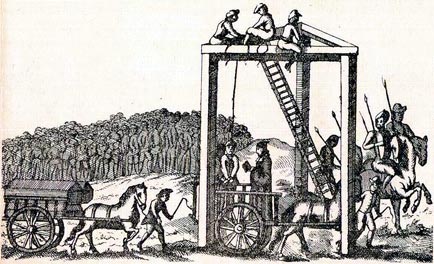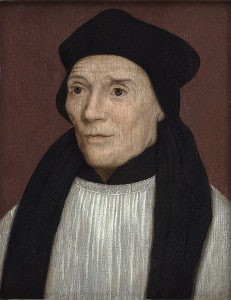On this day in history, the 20th of April 1534, Elizabeth Barton, known as “the Nun of Kent” or “the Holy Maid of Kent”, was hanged for treason at the gallows at Tyburn, but who was she and what did she do to deserve such a death?

The Nun of Kent
Elizabeth Barton went from being an ordinary servant girl to a religious visionary in 1525, at around the age of nineteen. She was working in a household in Aldington, Kent, when she was taken ill and fell into trances where she had visions which were “of marvellous holiness in rebuke of sin and vice”.
Richard Master, the local parish priest, was convinced that her visions were genuine and so reported the matter to William Warham, the Archbishop of Canterbury who sent a commission consisting of her parish priest, a diocesan official, two Franciscans (Richard Risby and Hugh Rich) and three Canterbury Benedictines (Bocking, Hadleigh and Barnes). This commission as also convinced of Barton’s sincerity and pronounced in her favour. Shortly after Barton was examined, one of her predictions came true – in front of a large crowd, Barton was cured of her illness by the Blessed Virgin. At this time, her visions and prophecies seemed harmless as they were simply encouraging people to live a good Catholic life.
After being cured of her illness, Elizabeth Barton left her job as a servant to become a Benedictine nun near Canterbury. She carried on having visions and became a bit of a celebrity, becoming known as the “Nun of Kent” or the “Holy Maid of Kent”. People would undertake pilgrimages to see this nun who was thought to communicate directly with the Virgin Mary. She was humoured by the English government, and even corresponded with people like Sir Thomas More and Bishop John Fisher, and actually met with Cardinal Wolsey, but then she started opposing Henry VIII’s plans to annul his marriage to Catherine of Aragon and marry Anne Boleyn. No longer was she a harmless nun, she was a threat to Henry VIII’s popularity and what she was saying could be classed as treason.
The Nun of Kent versus Henry VIII
According to Nancy Bradley Warren, author of Women of God and Arms: Female Spirituality and Political Conflict, 1380–1600, in 1532 Elizabeth Barton claimed to have been miraculously and invisibly present when Henry VIII attended Mass in Calais during his visit to see the French King. She reported that an angel denied Henry the consecrated host, removed it from the priest’s hands and, instead, offered it to Elizabeth Barton. She said that this was a clear sign that God was displeased with Henry. Barton also prophesied that if Henry proceeded with his divorce and married Anne Boleyn, then he would lose his kingdom within a month and “should die a villain’s death”. Nancy Bradley Warren writes of how Elizabeth Barton and her prophecies “struck at the heart of Henry VIII’s foreign policy and, perhaps even more significantly, at the heart of his representation of the English monarchy”.
It was clear that she was now a threat to Henry and his plans and this threat had to be dealt with. In 1533 Elizabeth Barton was examined by the new Archbishop of Canterbury, Thomas Cranmer. Having had her reputation damaged by rumours of sexual misconduct with priests, it is said that Elizabeth Barton confessed to fabricating her prophesies. Barton. She was then imprisoned in the Tower of London, along with her supporters like Bocking and Hadleigh, and forced to do public penance and make a public confession at St Paul’s Cross.

In January 1534, Elizabeth Barton and thirteen of her supporters were accused of treason by a bill of attainder. Those accused included Sir Thomas More and Bishop John Fisher, but More escaped when he produced a letter he had written to Barton in the past, telling her that she should not meddle in state affairs. Bishop Fisher and five of the other sympathisers were condemned to imprisonment and Barton and seven others, including Risby, Rich, Bocking and Masters, were condemned to death. Fisher was later pardoned. Here is what is recorded in the Letters and Papers from Henry VIII’s reign from the 15th January 1534:-
“Names of those implicated with Eliz. Barton:-”
Eliz. Berton, nun, Edw. Bokkyng, John Deryng, Ric. Master, Harry Gold, Hugh Ryche and Ric. Rysby. These by the Act shall be attainted of high treason and suffer death.
John bishop of Rochester, Adyson, clerk, his chaplain, Thomas Gold, Thomas Laurens. Edw. Thwaytes, gent., Thomas Abell. To be attainted of misprision. suffer imprisonment at the King’s will and lose all their goods.” (L&P vii 70)
On the 20th April 1534, Elizabeth Barton and her accomplices were executed at Tyburn gallows.
Prophecies or Falsehoods
It is not known whether Elizabeth Barton confessed of her own volition or whether she was tortured, either physically or psychologically. It is impossible to judge whether Elizabeth was a fraudster, mentally ill or medically ill. She may have suffered from fits, she could have been delusional or perhaps she did have visions or what she believed to be visions, we just can’t say. She did manage to convince a lot of people though, didn’t she?!
At the end of the day, Elizabeth Barton may well have been a tragic victim of a society where mental illness or medical conditions, such as epilepsy, were completely misunderstood. She challenged a king and that king won.
Sources
- Attainder of Elizabeth Barton and Others – Letters and Papers, Foreign and Domestic, Henry VIII, vii 54, 70.
- New Advent Catholic Encyclopedia
- Luminarium.org article on Elizabeth Barton
- The American Historical Review – Review of Nancy Bradley Warren’s Women of God and Arms: Female Spirituality and Political Conflict, 1380–1600
- Wikipedia page on Elizabeth Barton